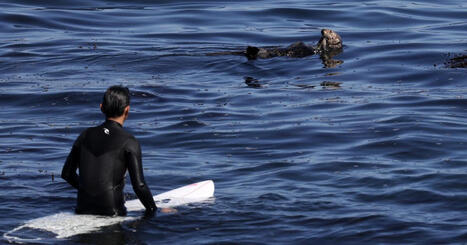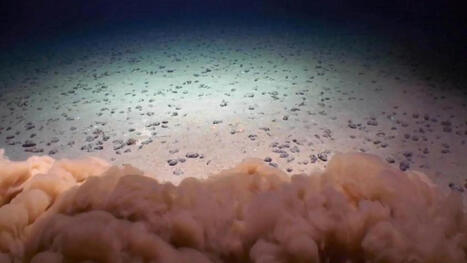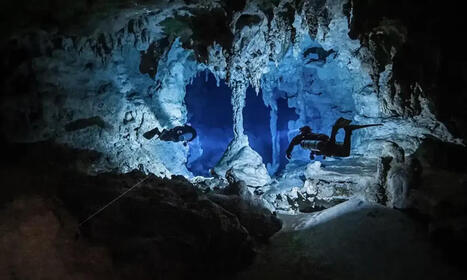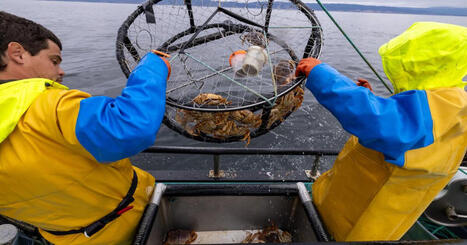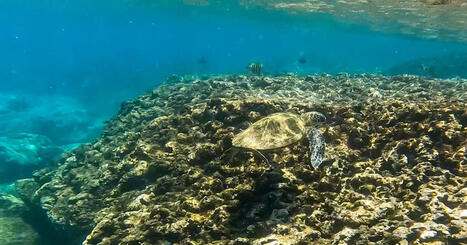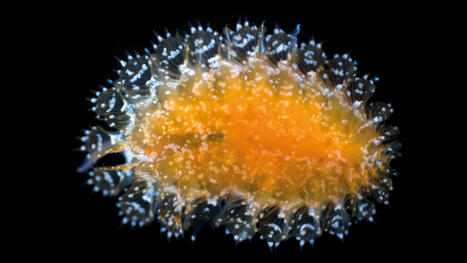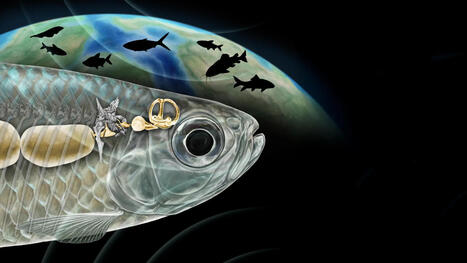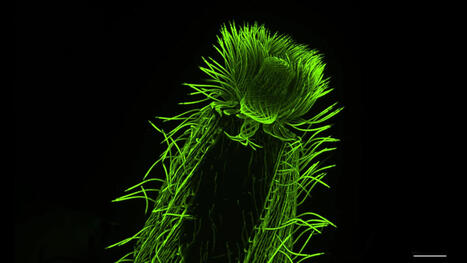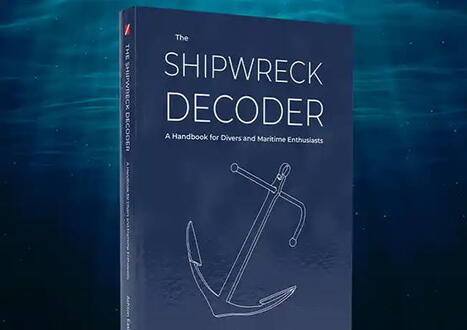 Your new post is loading...
 Your new post is loading...

|
Scooped by
Grant W. Graves
November 9, 8:35 PM
|
An otter is hopping on surfboards in Santa Cruz's storied Steamers Lane. Two years ago, a similar situation played out in these prime surfing waters. Is it the same otter? A different one? And what benefit, if any, is this otter gaining by accosting surfers and boaters?

|
Scooped by
Grant W. Graves
November 9, 8:29 PM
|
A group that is pioneering underwater sculpture parks as a way to establish human-made coral reefs has deployed its first installation off Miami Beach.

|
Scooped by
Grant W. Graves
November 9, 8:17 PM
|

|
Scooped by
Grant W. Graves
November 9, 8:12 PM
|

|
Scooped by
Grant W. Graves
November 9, 8:06 PM
|

|
Scooped by
Grant W. Graves
November 9, 7:55 PM
|
Researchers at UC San Diego have figured out how to get bacteria to produce xanthommatin, the pigment that lets octopuses and squids camouflage. By linking the pigment’s production to bacterial survival, they created a self-sustaining system that boosts yields dramatically. This biotechnological leap could revolutionize materials science, cosmetics, and sustainable chemistry.

|
Scooped by
Grant W. Graves
November 9, 7:51 PM
|
Deep beneath the ocean, scientists uncovered thriving microbial life in one of Earth’s harshest environments—an area with a pH of 12, where survival seems nearly impossible. Using lipid biomarkers instead of DNA, researchers revealed how these microbes persist by metabolizing methane and sulfate. The discovery not only sheds light on deep-sea carbon cycling but also suggests that life may have originated in similar extreme conditions, offering a glimpse into both Earth’s past and the limits of life itself.

|
Scooped by
Grant W. Graves
November 9, 7:45 PM
|
Beneath the ocean’s surface, bacteria have evolved specialized enzymes that can digest PET plastic, the material used in bottles and clothes. Researchers at KAUST discovered that a unique molecular signature distinguishes enzymes capable of efficiently breaking down plastic. Found in nearly 80% of ocean samples, these PETase variants show nature’s growing adaptation to human pollution.

|
Scooped by
Grant W. Graves
November 9, 7:37 PM
|
Scientists have discovered that deep-sea mining plumes can strip vital nutrition from the ocean’s twilight zone, replacing natural food with nutrient-poor sediment. The resulting “junk food” effect could starve life across entire marine ecosystems.

|
Scooped by
Grant W. Graves
November 9, 7:26 PM
|

|
Scooped by
Grant W. Graves
November 9, 7:18 PM
|

|
Scooped by
Grant W. Graves
November 9, 7:04 PM
|
For nearly 30 years, Robbie Schmittner has mapped the hidden veins of the Yucatán. Now, with Koox Baal linked to the Mother of All Cenotes, he’s closer than ever to uniting a cave system that could become the largest on Earth.

|
Scooped by
Grant W. Graves
November 9, 6:58 PM
|
Karst Underwater Research and Team FATHOM, recently shared a series of behind-the-scenes clips from their latest expedition to a remarkable underwater cave system in West Texas—the deepest known underwater cave in the United States, reaching depths of around 170 m/558 ft.
|

|
Scooped by
Grant W. Graves
November 9, 8:32 PM
|
Humpback whales and domoic acid contamination are putting the brakes on California's commercial Dungeness crab fishery this fall. Holiday crabs and crab cakes won't be easy to find.

|
Scooped by
Grant W. Graves
November 9, 8:27 PM
|
There's new momentum to revive eating green sea turtles in Hawaii, a practice with a long cultural history for Native Hawaiians.

|
Scooped by
Grant W. Graves
November 9, 8:15 PM
|

|
Scooped by
Grant W. Graves
November 9, 8:09 PM
|

|
Scooped by
Grant W. Graves
November 9, 7:57 PM
|
Scientists are revolutionizing how new marine species are described through the Ocean Species Discoveries initiative. Using advanced lab techniques, researchers recently unveiled 14 new species from ocean depths exceeding 6,000 meters. Their findings include a record-setting mollusk, a carnivorous bivalve, and a popcorn-like parasitic isopod. The project aims to make taxonomy faster, more accessible, and globally collaborative.

|
Scooped by
Grant W. Graves
November 9, 7:53 PM
|
Long ago, some saltwater fish adapted to freshwater — and in doing so, developed an extraordinary sense of hearing rivaling our own. By examining a 67-million-year-old fossil, researchers from UC Berkeley discovered that these “otophysan” fish didn’t evolve their sensitive Weberian ear system in rivers, as long thought, but rather began developing it in the ocean before migrating inland. This new timeline suggests two separate invasions of freshwater, explaining why so many freshwater species exist today.

|
Scooped by
Grant W. Graves
November 9, 7:48 PM
|
A pandemic-era breakthrough has allowed scientists to literally expand our view of plankton. By using ultrastructure expansion microscopy, researchers visualized the inner workings of hundreds of marine species for the first time. The effort, tied to the TREC expedition, maps the evolutionary architecture of life’s smallest ocean dwellers. It’s the start of a global atlas revealing how complexity evolved beneath the waves.

|
Scooped by
Grant W. Graves
November 9, 7:42 PM
|
A revolutionary eDNA test detects endangered hammerhead sharks using genetic traces left in seawater, eliminating the need to capture or even see them. This powerful tool could finally uncover where these elusive species still survive, and help protect them before they disappear for good.

|
Scooped by
Grant W. Graves
November 9, 7:31 PM
|
Researchers from the University of Vienna discovered MISO bacteria that use iron minerals to oxidize toxic sulfide, creating energy and producing sulfate. This biological process reshapes how scientists understand global sulfur and iron cycles. By outpacing chemical reactions, these microbes could help stop the spread of oceanic dead zones and maintain ecological balance.

|
Scooped by
Grant W. Graves
November 9, 7:21 PM
|

|
Scooped by
Grant W. Graves
November 9, 7:09 PM
|
Last year, orcas sashayed into the world of fashion with dead salmon hats.

|
Scooped by
Grant W. Graves
November 9, 7:00 PM
|
Shipwrecks are often described as underwater time capsules but, for many divers, the tangle of steel, timber, and machinery can be difficult to interpret. A new book, The Shipwreck Decoder by Ashton East, aims to change that, offering a practical illustrated guide to understanding the design and history of sunken vessels.
|
 Your new post is loading...
Your new post is loading...
 Your new post is loading...
Your new post is loading...




